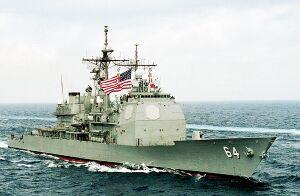Ticonderoga-class
| This article may be deleted soon. | ||
|---|---|---|
Ticonderoga class cruiser]]s are major surface combatants of the United States Navy]], principally as the primary escort ship for a Carrier Strike Group]] or Expeditionary Strike Group]], an independent unit, or the leader of a surface action group. They can carry out anti-air warfare]] (AAW), Naval Surface Fire Support (NSFS), anti-submarine warfare]] (ASW), land attack]] and anti-surface warfare]] (ASuW) missions, and, in some cases, ballistic missile defense]]. The earliest models have been retired, and all current ships carry the AEGIS battle management system]] and a large number of vertical launch system]] missile tubes, as well as supplementary weapons. They have the space and communications to serve as flagships for small forces, and frequently, even when the task group commander is on an aircraft carrier]] or large amphibious warfare]] ship, carry the group anti-air warfare]] officer. ' All are equipped with the Joint Tactical Information Distribution System]], which, among other functions, let them participate in an integrated air defense system]] with land and air platforms. Series/flightsCG47-51 did not have vertical launch system]]s; all have been retired. These formed Baseline 0 and Baseline 1. Baseline 0
Yorktown was subsequently used as an engineering test ship to test the capabilities of using Microsoft Windows as an operating system for tactical applications. Baseline 1
Baseline 2There are seven Baseline 2 ships, CG52-58. CG 54 and 55 had stand-alone AN-|AN/]]SQR-19]] towed sonar arrays and AN-|AN/]]SQS-53|SQS-53A]].
CG 53 and later substituted a 24 ft Rigid Inflatable Boat (RIB) for the 26 ft motor whaleboat.
CG 56 introduced the AN-|AN/]]SQQ-89|SQQ-89(V)3]] integrated ASW suite, with AN-|AN/SQS-53B]] sonar, AN/SQR-19 towed array, and the Mk 116 Mod 6 underwater fire control system.
Baseline 3In Baseline 3 are six ships, CG59-64. They were built with AN/SPY-1B radar and AN/UYQ-21 consoles. The lighter SPY-1B radar, with improved radiating characteristics, was substituted for SPY-1A, and new computers (AN-|AN/]]UYK-43]] and AN-|AN/]]UYK-44]] in place of AN-|AN/]]UYK-7]])
Baseline 4Nine Baseline 4 ships, CG65-73, complete the series. T1. CG 65-73 have the improved AN-|AN/]]UYS-20]] data display system . All ships of the group had the SQS-53C sonar and the AN-|AN/]]SQR-17]] sonar data processor.
Integrated combat systemsAt the heart of the combat capabilities is the AEGIS battle management system]], which links a number of radar]]s, computers, and fire control system. The core radar is an SPY-1|AN/SPY-1]] radar#passive electronically scanned array|passive phased array]], which can be upgraded with a SPY-2|AN/SPY-2]] ballistic missile defense capability. USS Lake Erie (CG-70)]] and USS Port Royal (CG-73)]] were the ballistic missile defense test ships; all ships will be retrofitted with the capability. The most basic improvement was adding the AN/SPY-2 capabilities to the phased array radars. Anti-air warfareThe Tico has one more SPG-62|AN/SPG-62]] final missile guidance radar than a Burke-class]] destoyer. These radars are time-shared in any case, so either ship class can control more missiles than they have illuminators. In addition, they have a longer-range secondary air search radar that the Burkes do not, the SPS-49|AN/SPS-49]]. Mounted higher than the SPY-1, it has a longer horizon, especially good against sea-skimmers. With an AEGIS feature called Cooperative Engagement Capability]] (CEC), a given AEGIS system can guide SM-2 SAMs fired by other ships in the formation, so as long as a Burke had the Mark 99 launch control system working, it could fire SAMs "blind" and have another AEGIS vessel control them. Assuming the Burke also has CEC, however, the reverse could be true; the SAMs could be launched by a Tico and controlled by a Burke. In the Gulf War, the USS San Jacinto, a Tico, was designated the "special weapons platform", carrying 122 Tomahawks. The normal Tico loadout is 12 Tomahawks and 110 SM-2. Anti-surface warfareRIM-156 Standard SM-2]] missiles can be used in a surface-to-surface mode, with or without midcourse guidance from helicopter radar. The 5" guns are primarily for naval gunfire support ashore, but can be used against ships. They have light 25-mm Mk 38 Bushmaster chain guns in Mk 88 mountings, for use against boats. Anti-submarine warfareThe SQQ-89|AN/SQQ-89]] ASW Combat System controls the RUM-139 Vertical Launch ASROC]] and the final-defense Mark 46 torpedo]]es in deck launchers. In addition to helicopter sensors, the later ships carry
General characteristics
ArmamentVLSImage:SM-3 US-Japan.jpg|thumb|joint U.S.-Japan RIM-161 Standard SM-3]] firing from USS Lake Erie (CG-70)]]]] The major weapons are missiles fired from the MK41 vertical launching system, managed by the Mark 99 fire control system. For anti-aircraft use, they carry the long-range RIM-156 Standard SM-2]] and medium range RIM-162 ESSM]]; the ESSM come in four-packs for every VLS cell. Ships with the ballistic missile defense electronics upgrades also carry RIM-161 Standard SM-3]] vertical launch missiles, with capability against theater ballistic missiles and satellites; they can tie their radars into a national ballistic missile system. For long-range antisubmarine warfare, they have RUM-139 Vertical Launch ASROC]] missiles. For the land attack role, they carry the BGM-109 Tomahawk]] cruise missile]] Non-VLS
InternationalThe U.S. and Japan are actively cooperating in theater ballistic missile defense. Their Kongo-class destroyer]]s, essentially a clone of a Flight I Burke-class]] destroyer, is now integrating the SM-3 BMD capability. Japan has also bought U.S. Army MIM-104 Patriot]] missiles for point BMD defense, the SM-3 being longer-range and a logical complement in a layered defense References |
||
